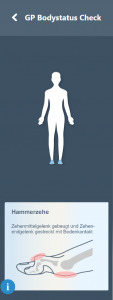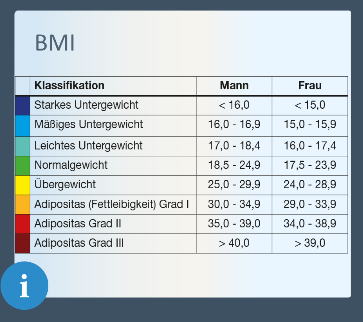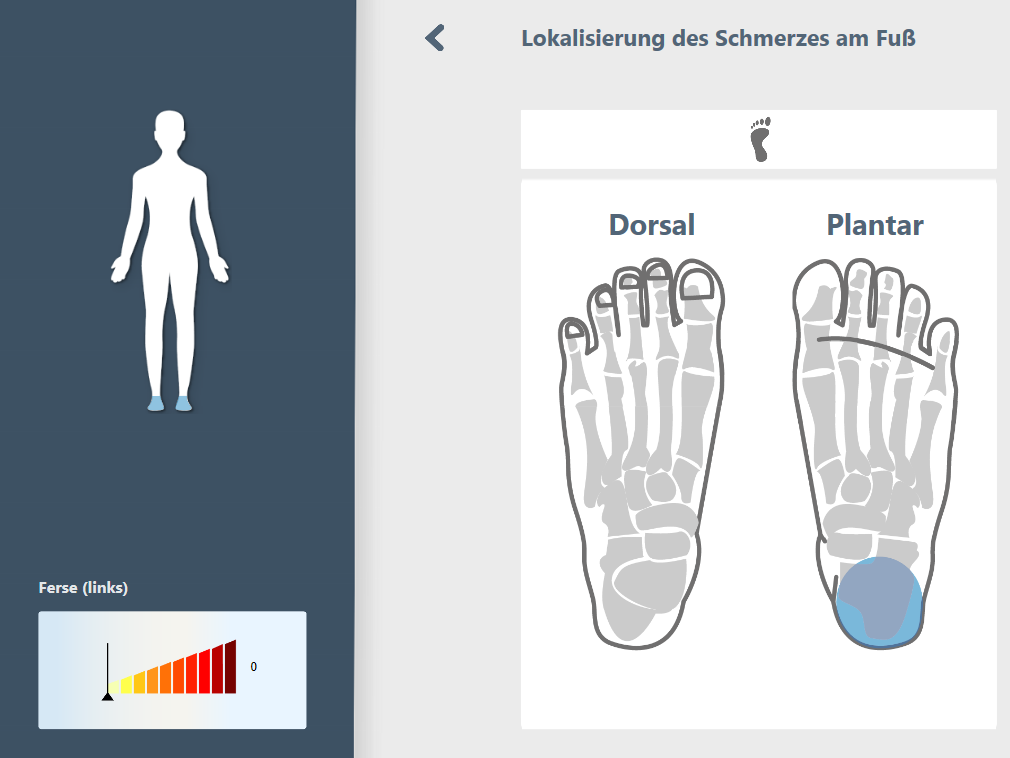Functions
Click on the blue info button (Figure 6) to open the info window at the bottom left of the screen (Figure 7).

Figure 6: Info button
Here you will find images, texts and/or GIFs to help you.

Figure 7: Info field
Calculation of body mass index (BMI) (customer data)
Once you have entered the height [cm] and weight [kg] data, you can log in by left-clicking on the [Calculate BMI] (Figure 8) to calculate the body mass index and take the rating from the table (Figure 9) in the info window.

Figure 8: BMI calculation

Figure 9: BMI table in the info field
Pain specification via slider
The pain data is always collected separately for the left and right side.
The pain is specified using a slider (Figure 10). Here you can use the left mouse button to move the slider to the appropriate number, which is also displayed next to it. The scale goes upwards from 0 to 10, with zero meaning no pain and ten meaning the most severe pain imaginable. You will find the numerical value in the PDF output.

Figure 10: Slider for pain indication
In addition, the localisation of the pain can be indicated for the foot and thigh (Figure 11).
Select the affected area in the illustration. This is then highlighted in light blue and the corresponding slider opens in the info window. Select the corresponding pain area here. The following areas can be selected:
Dorsal:
- Toes (total)
- Bunion
- Small toe bunion
- Tension
Plantar:
- Toes (total)
- Metatarsal heads (total)
- Plantar fascia
- Heel
The programme saves your selection by selecting a different area or by pressing the Next button. This pain indication is output in the PDF. If you then select a new area, your previous selection remains saved, but there is no marker on the foot image.

Figure 11: Pain information on the foot: You select an area of the foot (in the picture: heel on the left). The area is then highlighted in colour and the pain slider opens in the info window. Your selection is saved and displayed in the PDF.
Edition PDF
After you have gone through all the questions, the Next button on the last page automatically creates a PDF document that summarises your medical history clearly.

Figure 12: PDF output
Under the button [e-mailThe PDF document can be sent by e-mail (Figure 12). To do this, enter your customer's e-mail address and press accept. The GP Mail module must be set up for this function. You also need a valid e-mail address for sending.
With the button [Output PDFThe Windows print function opens in a separate window. Here you have the option of saving and/or printing the document. To save, select the "Printer" Microsoft Print to PDF (Figure 13) and to print, select your printer. The anamnesis is then finished and you can return to the start page via the back button at the top left or via the [Finish anamnesis].

Figure 13 Printer settings for saving the PDF